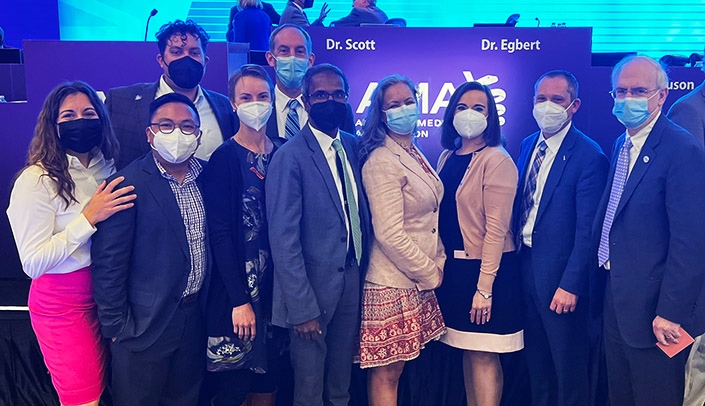When Kelly Caverzagie, MD, looked around the American Medical Association’s House of Delegates meeting, he noticed something.
A lot of other UNMC leaders, faculty, residents, and students.
"There was no official tally, but we were very likely the largest delegation from any single institution in the AMA," Dr. Caverzagie said.
The June 10-15 event gathered members from across the country, including all states and specialties, to establish policies and set the agenda for the AMA’s advocacy efforts. The UNMC attendees were not there as representatives of the university, Dr. Caverzagie said – instead, delegates represent state medical associations, national medical specialty societies and other interested or affiliated associations.
Still, it was plain to see that UNMC leaders, faculty, residents and students have significant influence in the AMA House of Delegates, Dr. Caverzagie said.
"While we all represent different societies and organizations, the fact is that we are all here in an advocacy role."
UNMC Chancellor Jeffrey P. Gold, MD, a former chair of the AMA Council on Medical Education and a longtime delegate for the Society of Thoracic Surgeons, is a firm a supporter of physician and student involvement in organized medicine.
"The AMA is an important voice of American physicians," said Dr. Gold, who has been a member of the AMA since the early 1980s. "The level of participation among UNMC physicians is gratifying, as it allows UNMC physicians who are familiar with state and national medical and health issues to add their thoughts on these important concerns."
Dr. Gold’s ongoing leadership shows the institutional commitment to the AMA and other organized professional societies and provides a visible example of the importance of this type of outreach, Dr. Caverzagie said.
"I was pleased to see the large UNMC representation at the meeting," Dr. Caverzagie said. "This type of professional participation is important, because it is through organizations such as the AMA that we – as physicians and students — can advocate for things that we believe in, for our patients and for the communities we care for."
Jordan Warchol, MD, was part of that UNMC representation. An AMA member since 2009 and actively involved since 2014, Dr. Warchol was on hand as a delegate of the Nebraska Medical Association and chair-elect of the AMA Young Physicians Section. She also was pleased to see so many UNMC colleagues at the meeting.
"I’d love for every faculty member at UNMC to be a member of the AMA," she said.
Since physicians are established leaders of the health care team, leadership is important in the advocacy arena, Dr. Caverzagie said. "We all work to ensure we are meeting the mission of caring for patients — working with organized medical societies helps us to effect the meaningful change we seek. An organized network drives change for the better."
As medical and public health controversies continue to arise in the national discourse, Dr. Caverzagie said, physicians, including the delegation from UNMC, continue to strongly advocate to maintain the sanctity of the physician-patient relationship.
"That’s the crucible of our profession, advocating for the patients and populations we serve," he said.
Dr. Warchol, who holds a master's degree in public health and served as a health policy advisor to Utah Sen. Orrin Hatch in 2017-18, said she has seen firsthand the impact the AMA can have on national health policy.
"When the powers that be — the House, the Senate, other national leaders — are looking at legislation that’s going to impact medical care on a large scale, it’s the AMA they turn to," she said. "They’re not looking to specialty societies or hospital associations.
"So, it’s critically important to the future of the profession for physicians to continue to have active participation and membership in the AMA — to continue to support medicine and to model that behavior for our trainees," she said. "The AMA will continue to speak out against misinformation and disinformation, and the more members we have, the more credibility we receive as an important voice in these discussions."
Dr. Caverzagie, who attended the June meeting as a delegate from the Nebraska Medical Association, is also member of the AMA Council on Medical Education. He first became involved in the AMA as a medical student and he was pleased to see the broad representation at the meeting, including quite a few current UNMC students.
"It was a lot of fun to see the broad representation from UNMC ranging from the chancellor of the university all the way down to second-year medical students, with about 10 people in between," he said. "The long continuum that was there, was pretty impressive."
Dr. Caverzagie also praised the UNMC Alumni Council, which – along with strong support of the Nebraska Medical Association — supported some travel expenses for the students.
"This type of institutional commitment to advocacy and education is phenomenal," he said. "Having the commitment of our leadership to recognize the value of advocacy, leadership, engagement, and membership – in many organizations, not just the AMA – speaks to the UNMC community’s commitment to serve as physician leaders and actively work to improve things for our profession and our patients."
